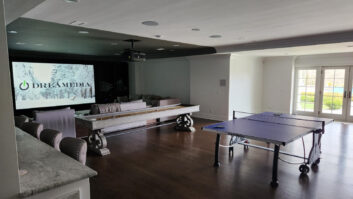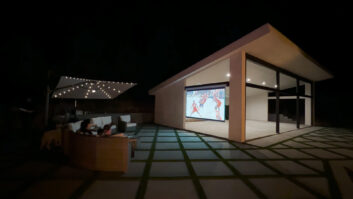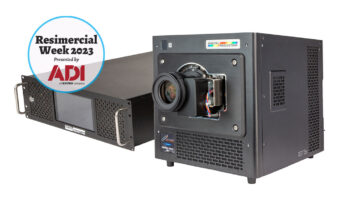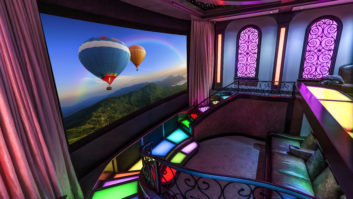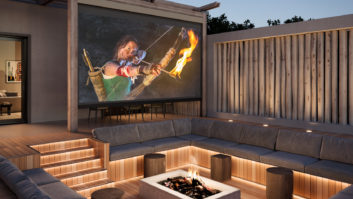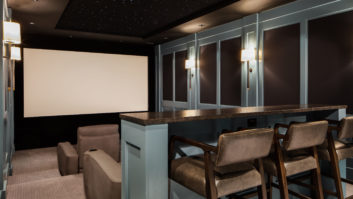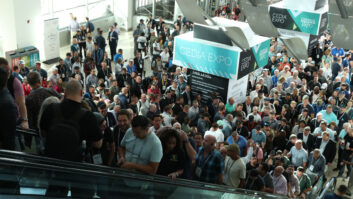Suspension of disbelief–the total immersion of oneself in an on-screen experience such that the temporal world falls away–requires one thing above all else: a really large screen. It’s a sensation that even very big flat panel TVs can’t quite deliver. But with the continued development of new projection screen assemblies and materials, it’s something that doesn’t require a dark, dedicated theater room to achieve–and something that more and more people can afford to enjoy.

Zero-G from Screen Innovations was developed for use in unconventional settings, like living rooms, where aesthetics are an important factor.
“One of the things we have been focused on is devising more cost-effective ways for integrators to deliver this lavish Hollywood screening room-type of functionality and experience, but at reduced costs,” said Chris Seymour, managing director, Seymour-Screen Excellence. To do this, the company’s TAM-1T screen employs a “single-motorized-top-drop-down” masking system that alters the height of the screen to fit aspect ratios from 1.78:1 to 2.4:1, while the width of the viewing area remains constant.
“By eliminating the somewhat costly second masking assembly we are able to pass along a cost savings of approximately 30 percent less than our TAM-2 dual-masking systems,” Seymour said. “We see good opportunities for dealers to turn to TAM-1T for rooms where they are striving for the highest-caliber theater experience however budget is a relevant factor.”
One of the biggest factors pushing the two-piece projection market is the growing popularity of 4K video. To truly appreciate the expanded detail that such content provides, a very large screen is a necessity.

The TAM-1T screen from Seymour-Screen Excellence employs a masking system that alters the height of the screen to fit aspect ratios from 1.78:1 to 2.4:1, while the width of the viewing area remains constant.
“Projection-based entertainment systems are uniquely capable of producing truly immersive experiences through a combination of razor-sharp 4K images and carefully engineered sound broadcasting,” said Aaron White, national sales manager–residential and commercial at Severtson Screens. “By manufacturing screens from materials that are both 4K compatible and acoustically transparent, Severtson takes advantage of these important aspects of modern projection technologies. The result is a line of projection screens that integrate seamlessly with the most advanced projection technologies available.”
As high-resolution projection technology becomes increasingly more affordable, consumers are beginning to consider it as an alternative to flat panel displays in living rooms and similar spaces. It is in these use cases that today’s projection screen technology really shines. “When you bring the big screen out of the controlled darkness of home theater rooms, a specialized material is needed to eliminate the washout effects of ambient light,” said Dave Rodgers, marketing manager, EPV Screens and Elite Screens. “Although a brighter projector (higher lumens) will help with image brightness, it doesn’t help with color contrast or black levels because it directs all of the brightness in the room, not just the projected image, into the viewer’s field of vision.”
That’s where ambient light-rejecting (ALR) materials come in. ALR screens like PolarStar eFinity from EPV filter out indirect light so that only the light from the projector is reflected back to the viewers, cutting down on glare. According to Rodgers, the optical-filter design of the PolarStar eFinity material enhances black levels and color contrast, permits active and passive 3D content to be displayed, and improves the visibility of shadows, textures, and slight gradations in color shading.

Phantom HALR screens from Stewart Filmscreen feature a two-layered ambient light-rejecting design, and can be made in seamless sizes up to 40 feet by 90 feet.
Stewart Filmscreen is another pioneer of ALR materials, and recently released a new variant, the Phantom HALR. “A High Ambient Light Rejecting projection screen material that delivers incredible image fidelity and uniformity, Phantom HALR resolves several issues that have, in many ways, plagued the category for many years,” said Vijita U.G., Stewart Filmscreen’s marketing manager. “Now, consumers can enjoy a true bigscreen (or giant screen, in the case of Stewart Filmscreen) experience in any room of the house, day or night.”
Available in seamless sizes up to 40 feet by 90 feet, Phantom HALR material is the only black screen material that can be perforated for acoustical transparency, according to the company. The screen is actually composed of two layers: an outer transmission layer with dark coating, and an inner layer, with a highly reflective optical coating. Incoming light from the projector passes through the outer layer and is reflected back to the viewers, while light from other angles is absorbed, allowing it to perform well regardless of the brightness of the room.
Of course, if you’re going to put a projection setup in the middle of a living room, lightrejecting performance isn’t going to be the only consideration. In these situations, “the aesthetics of the screen are driving the design,” said Tabi Quick, director of residential sales at Screen Innovations (SI). “SI is putting screens in places like the living room where customers need something that appeals to the look and feel of the room. Our new motorized screen, Zero-G, was born from this perspective. When down its design is sleek and beautiful. The image appears to be floating in the air. The best thing about the Zero-G is it disappears when not in use.”

EPV’s PolarStar eFinity material enhances black levels and color contrast, and improves the visibility of shadows, textures, and slight gradations in color shading.
The Zero-G model is available with a choice of screen materials, including the company’s Slate ALR material that blocks out 65 percent of ambient light, with gain options of 1.2 and 0.8 for optimal contrast.
Speaking of optimal contrast, there are other factors besides ambient light levels that dictate the proper screen material for each application. “One is the projector, of course, two is the desired content, and three, and perhaps most important, is the lighting in the room,” said Amy Madden, residential market manager at Draper. “If we know these three things, we can help the dealer choose a screen that will get them to whatever contrast level they need.”
And Draper offers plenty of choices to help them dial in the performance, Madden said. In its TecVision line, there’s a choice of nine different material formulations, starting at a gain 0.7 gray all the way up to a 1.8-gain white, with a new 1.2 gray ALR material due to be added shortly. “In the past it was easy for dealers to have a favorite projector and favorite screen, and use the same system over and over again,” Madden said. “While it is still possible to do that today, the dealer can add more value to their design by properly looking at the individual factors in determining the right screen to use.”
Regardless of setting, there are few things an integrator can install that bring clients more value, from an entertainment standpoint, than a properly designed two-piece projection system. And with the wide selection of screens available today, the larger-than-life experience can be enjoyed almost anywhere: from dedicated theater rooms to bright studio apartments, and everything in between.
Matt Pruznick is managing editor of digital content for Residential Systems and Systems Contractor News. Follow him on Twitter @Pruznick.
